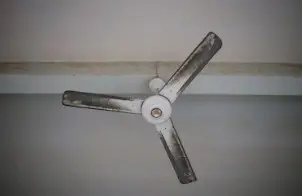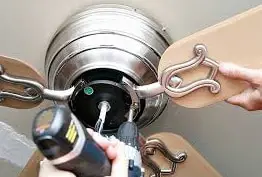It’s not very often that you will come across a noisy ceiling fan, but when you do, it is quite an annoyance.
The main problem is how to quiet a noisy ceiling fan. There are so many different issues that can be causing a noisy fan.
The first thing you must figure out is what is causing the noise in the first place.
Not too long ago, the ceiling fan in my room started to make a loud squeaking noise when it was spinning at medium speed or higher.
This is a problem for me because I have a newborn, and she is the lightest sleeper. One wrong breath, and she will be awake almost immediately.
You can only imagine what a squeaky ceiling fan will do on the hotter days. It gets expensive to run the air conditioner all day during the summertime, which made me want to fix this issue as soon as possible.
This is what lead me to research all the different issues that can cause a ceiling fan to be noisy.
Prepare Your Fan for Inspection
This is the first step to take when diagnosing the problem with your ceiling fan. It’s easy to guess and say that the noise is caused by the internal motor, which isn’t always the case.
Sometimes noise can come from a poor installation, dirty blades, the motor, bearings, or other parts of the fan.
Before beginning any type of inspection, you will want to make sure the fan is powered off. This is mainly due to safety reasons and to help you diagnose your fan one noise at a time.
Sometimes your fan me be making noises in more than one part at a time which can make this difficult to diagnose if the fan is moving at full speed.
Inspect and Clean the Fan Blades

Dirty fan blades can cause your fan to shake and wobble uncontrollably because they throw your fan off balance.
First, make sure the fan light, as well as the fan itself, is in the off position.
You will want to clean both sides of the fan with either a microfiber cloth duster or with a slightly damp cloth or paper towel.
I recommend using this microfiber ceiling fan duster from amazon over just a traditional cloth and water because it will be a lot easier to clean your fan.
You can even attach a telescopic pole like this one onto the microfiber duster if your fan is very high.

Without a pole and a duster, you would probably need to stand on a chair or get a ladder to clean your fan with a cloth and water.
Having a microfiber duster and telescopic pole handy will make it easy to clean all the ceiling fans in your house without much effort every time you see that they need to be cleaned.
A good tip to remember is that the top sides of the fan will be much dirtier than the bottom.
If you decide to clean your fan with water instead of a microfiber duster, then you must make sure to dry any moisture from the blades right away.
Many fans are made from wood-composite or different particleboard materials that can easily damage if left wet.
Inspect Your Fan for Damage During Cleanings
It is a good idea to take a look at all of your fan blades while you are cleaning them to make sure they are still in good condition.
Check to make sure that all blades are straight and not warped, damaged, or hanging at different levels than the other blades.
If some of the blades are hanging lower than others, you may need to tighten them to fix the problem.
If your blade is either warped or damaged, you will need to replace the blade with an exact match from the fan’s manufacturer.
Never replace a fan blade with a random blade because you can throw your fan off balance, which can be very dangerous as well as noisy.
This can even burn out your fan’s motor because your fan will be working extra hard to rotate the blades.
Tighten Any Loose Fan Blades

There are many different areas on your fan that can become loose over time. These loose parts can cause different noises like rattling to occur.
The first thing you will want to check is your fan’s blades. They will usually mount to individual brackets.
These brackets are then mounted onto the fan’s motor assembly. Check to see what type of screws are holding in your fan blades.
You will most likely need to use a Phillips head screwdriver to tighten your fan since these are the most common screws that are used.
Be careful not to strip the bolts as you are tightening them. Usually, a #3 Phillips head screwdriver will be needed for a larger screw head.
If you use a #2 Phillips on a #3 screw head, you are more likely to strip them.
How to Assess a Wobbly Fan
A wobbly fan is among the leading cause of a noisy ceiling fan. There can be a number of reasons why your fan is wobbly.
Before you assess your fan, you will want to make sure everything is tight and the blades are straight.
Here are a few simple steps you can take to assess why your fan is wobbly.
- Turn off the main power source to your fan. If you have access to the appropriate breaker for your home, then go ahead and power off the breaker. If you don’t live in a home where you have access to the breaker, then just make sure your fan is powered off. You will be working around wiring with a metal tool, so this is mainly for your safety.
- Loosen the screws on your fan’s canopy cover and slide it down from the ceiling.
- Tighten the screws that secure the fan’s mounting bracket to your ceiling using a screwdriver. This area can tend to loosen after a long period of use from vibration. If you see that these screws are indeed loose, then this is probably the issue for your wobbly fan.
- Grab the mounting bracket with your hand and try to move it from side to side. This should be rock solid without having any play. If it moves, check to see if there are additional screws or nuts inside of the framing.
- Reinstall your fan’s canopy cover and restore power to your fan. Test the fan to see if it still wobbles. If your fan is still wobbling, then you can try to balance your blades.
How to Balance Your Fan

This fan balancing kit from amazon is super cheap and highly effective.
These kits will often come with new fans, but if you didn’t just buy a fan, then you probably don’t have a balancing kit lying around the house.
This was actually the main problem with the fan inside my bedroom.
The noise was coming from my fan being unbalanced. Using this simple balance kit solved all my problems for under 10$.
Before you balance your fan, you will want to make sure everything is tight and secure to properly isolate the problem. This kit comes with a plastic kit and a few stick-on weights.
To use the kit, simply place the clip onto the rear edge of one of the blades and turn on the fan. Inspect the fan to see if the wobble is gone.
If it is, then you have found the problem blade. Repeat this step on all of the blades of the fan to assess where placing the weight is most effective.
This kit specifically comes with 2 weights that you can attach. This should be more than enough to fix your problem.
After a few trial and error runs, you should have your fan pretty much wobble-free.
Assess Your Fan to See If the Ball Bearings Are Defective
If you suspect that the noise is actually coming from your fan’s internals, then this problem will most likely be the ball bearings going bad.
All ceiling fan motors use bearings to rotate. These bearings are similar to other types of bearings and need proper lubrication for them to work properly.
Nowadays, modern fans do not have to be manually lubricated. The bearings come in an enclosed form similar to that of a skateboard bearing or a fidget spinner.
These types of bearings usually require a lot of disassemblies and a professional to fix them.
If you have an older style fan, then you can manually lubricate the bearings yourself without too much work.
You will need a small can of lubricating oil to fill the fan’s oil pan. Once the oil pan is full, go ahead and turn the fan on for a short period of time.
You will fill the fan’s oil pan through a small hole in the housing of the fan. This is usually located on the top of the motor.
Fans that are able to be lubricated like this should also have a label at the top that should be visibly labeled. The fan will then re-lubricate itself as it runs at its normal speed.
The noise from the ball bearings should soon dissipate once the fan has had a while to re-lubricate itself.
Tighten Your Fans Light Fixtures
Most ceiling fans have some type of light fixture attached to them. Most fixtures on ceiling fans are secured with little thumb screws and are supposed to be tightened by hand.
Do not use tools to tighten these small screws. Using tools may cause you to over-tighten them and break the glass.
This is something that is easily overlooked because people are usually too busy checking out the fan’s motor and blades that they totally forget to make sure the light fixtures are tight.
Tips for a Quiet Ceiling Fan
- Clean your fan regularly to make sure that it is always running in perfect condition. Having a dirty fan can, in turn, lead to a wobbly fan which can mess up your motor or blades over time.
- Periodically check to make sure the light fixtures, fan blades, fan ceiling mount, and canopy are tight and secure to prevent any possible repairable damage.
- Try not to run your fan on the highest setting as this can make your fan accumulate more dust as well as wear out the motor faster.
- Always make sure your fan blades are dry after cleaning them if using water to prevent damaging the blades. Letting water dry on your fan blades can cause them to warp, which will then cause your fan to run imbalanced.
Invest in a New Ceiling Fan
If your fan is old, out of date, or just plain worn out, then it may be time to just pull the trigger and buy a new fan altogether.
You can find some nice modern fans at your local home improvement store. This is probably the most costly option, but if it’s long overdue, then now may be the time.
If you find your fan has way too many problems to address, then purchasing a new ceiling fan may be the best option for you.
Final Thoughts
I was able to solve my fan’s issue by making sure everything was nice and tight.
After that, I was able to balance my fan to eliminate the wobble it had that was causing all the noise. This is why the noise got worse with higher fan speeds.
Most of the time, you can fix a noisy ceiling fan by cleaning and tightening it. In rarer cases like mine, you will need to balance the blades.
In the worst-case scenario, if the noise is coming from your fan’s motor, you may need to hire a professional to fix the issue.

